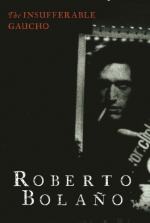|
This section contains 591 words (approx. 2 pages at 400 words per page) |

|
The Insufferable Gaucho Summary & Study Guide Description
The Insufferable Gaucho Summary & Study Guide includes comprehensive information and analysis to help you understand the book. This study guide contains the following sections:
This detailed literature summary also contains Quotes and a Free Quiz on The Insufferable Gaucho by .
This guide is based on the following version of the book: Bolaño, Roberto. The Insufferable Gaucho. Translated by Chris Andrews. New Directions Books, 2010. Published originally in Spanish in 2003.
The Insufferable Gaucho is a collection of five short stories and two lectures by Chilean-born author, Roberto Bolaño. In the first short story, “Jim,” an unknown narrator reflects on his memory of an American man and Vietnam War veteran named Jim living in Mexico City. The narrator recalls one day in particular when he dragged Jim away from a flame-eater on the street who was ominously approaching and would, perhaps, have set Jim on fire.
The second short story, “The Insufferable Gaucho,” centers around Manuel Pereda, an Argentinian lawyer, judge, and widowed father who, falling the collapse of the Argentine economy, moves from Buenos Aires to the pampas. There, he runs a small rancho called Alamo Negro and immerses himself in life there, even going so far as to become a rabbit hunter. One day, upon his return to Buenos Aires, Pereda stabs a cocaine-snorting writer in the groin with a knife.
“Police Rat,” the third short story in the collection, tells the story of Pepe the Cop, a rat living in the sewers and working as a police officer. Investigating the deaths of several dead rats, Pepe comes to the uncomfortable conclusion that a rat has been killing other rats—something that has never happened yet in the rat kingdom. Pepe the Cop confronts and kills the murderer, but knows that these deaths are the beginning of a moral and social decline in the rat kingdom.
Meanwhile, “Alvaro Rousselot’s Journey,” the fourth short story in the collection, tells the story of a mildly successful writer named Alvaro Rousselot who discovers that a French filmmaker has been plagiarizing his novels to great success. Rather than take legal action, Rousselot eventually goes to France and confronts the filmmaker. Though he feels bad about his actions in France, Rousselot realizes at the end of the story that he truly is an Argentine writer and that Argentine literature does indeed exist.
The final fictional entry in The Insufferable Gaucho consists of two related stories, “The Vocation” and “Chance” that together make up “Two Catholic Tales.” In “The Vocation,” an unnamed narrator expresses his desire to become a priest—technically, a saint like his idol and supposed ancestor, Saint Francis. When he sees a monk walking barefoot in the sand, he feels that he has received his calling to the priesthood. “Chance” is told from the perspective of an escaped mental asylum resident, Vicente, who, the reader realizes, is the monk seen in “The Vocation.” After Vicente escapes, he kills a priest and young boy, steals their clothes, and walks barefoot until he can get the chance to wash the blood off his shoes.
In “Literature + Illness = Illness,” the author speaks about his liver disease and the portrayal of illness in literature. In doing so, he uses two poems, one by Baudelaire and the other by Mallarme, to conclude that while illness and death are inevitable, we often turn to books and travel in the vain hope that they will provide us with an antidote or with medicine, despite knowing that they will only bring us closer towards death in the end.
In “The Myths of Cthulhu,” the final piece in The Insufferable Gaucho, the author bemoans the commercialization of Spanish-language literature, which is now dominated by bestselling authors more interested in social success than in speaking truth through art.
Read more from the Study Guide
|
This section contains 591 words (approx. 2 pages at 400 words per page) |

|



